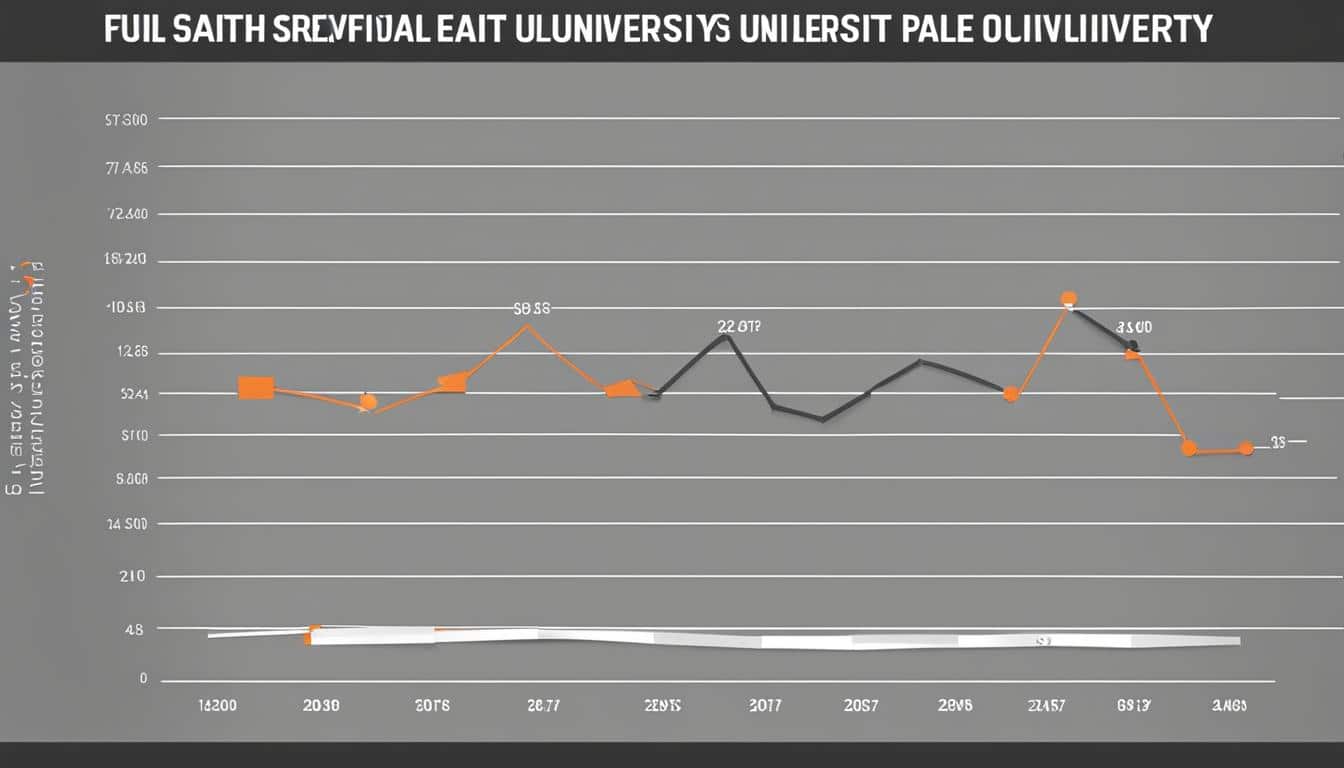Why Is Full Sail University Graduation Rate So Low : Full Sail University, a for-profit entertainment, arts, and media institution in Winter Park, Florida, has been raising concerns among prospective students due to its low graduation rate. According to the National Center for Education Statistics, the official Full Sail University graduation rate is 33%, based on students obtaining their bachelor’s degrees within six years. This figure falls below the national average graduation rates for both four and six-year rates, prompting many to question the factors contributing to this deficiency. This article delves into the reasons behind Full Sail’s low graduation rates and how they impact students’ experiences and outcomes.
Also Read: Experience Quality Education At Columbia Southern University
Key Takeaways
- Full Sail University’s graduation rate is lower than the national average for four and six-year completion rates.
- Intensive, specialized programs in entertainment, media, and arts industries may contribute to extended degree completion times.
- Financial factors, such as high tuition costs and the need for students to balance work and study, can affect graduation rates.
- Diverse student demographics, including non-traditional students, may play a role in retention and graduation outcomes.
- Academic rigor, case-by-case transfer credit evaluation and the university’s emphasis on industry readiness may all contribute to the low graduation rates.
- Full Sail University is working on retention initiatives and support services to improve graduation outcomes.
Understanding the Full Sail University Graduation Rate
Full Sail University’s graduation rate is determined by tracking the progress and completion of students within 150% of the defined program length, excluding those prevented from continuing due to specific circumstances like death, military service, or serious medical conditions. The statistics highlight that the retention rate for first-time/full-time freshmen is about 61%, which is approximately similar to the national average of 70%. For non-first-time undergraduates attending full time, the six-year graduation rate stands at 47%, while the rate of transfer within first-time/full-time students who did not graduate is around 4.6%. It is evident that the majority of Full Sail’s student body is made up of ‘traditional students’ who are attending full-time for the first time, and even within this demographic, only a fraction, about 29%, graduate within eight years.
Also Read: Explore The University of Arizona Global Campus: Your Path to Success
Full Sail University’s graduation rate is determined by tracking the progress and completion of students within 150% of the defined program length.
Graduation rates by student classification
| Student Classification | Retention Rate (national average) | Six-Year Graduation Rate | Transfer Rate |
|---|---|---|---|
| First-time, full-time freshmen | 61% (70%) | – | 4.6% |
| Non-first-time undergraduates (full time) | – | 47% | – |
As demonstrated in the table above, the graduation rates for various classifications of students at Full Sail University showcase a disparity in outcomes. Although the retention rate for first-time/full-time freshmen is relatively close to the national average, only about 29% of these traditional students graduate within eight years of enrollment. This leads to questions about the reasons behind the low graduation rates and whether Full Sail’s academic structure or other factors play a role in these outcomes.
- Retention rate for first-time/full-time freshmen
- Six-year graduation rate for non-first-time undergraduates attending full time
- Transfer rate within first-time/full-time students who did not graduate
An Overview of Full Sail University’s Academic Environment

Full Sail University is renowned for its unique academic environment, distinguished by specialized programs catering to the entertainment, media, and arts sectors. These sectors demand a highly intensive curriculum, with each program tailored to develop a deep understanding and mastery of the required skills.
Also Read: Welcome To Regent University – Where Leadership Is Learned
The Unique Challenges of Specialized Programs
Students enrolled in Full Sail University face various unique challenges due to the nature of their specialized programs. These tailored programs involve hands-on training, project-based learning, and extensive coursework, which often contribute to extended completion times. To graduate, students are required to achieve industry-standard proficiency in their chosen fields. Consequently, attaining a degree may necessitate additional time beyond traditional academic pathways.
“Full Sail University’s specialized programs, although highly intensive, aim to produce industry-ready graduates who excel in their creative careers.”
Full Sail predominantly caters to traditional students below the age of 25, yet still grapples with delayed graduation rates for this demographic. A critical factor contributing to these delays is the comprehensive curriculum-designed to offer an in-depth understanding of each subject matter.
Factors impacting completion times of specialized programs at Full Sail University:
- Hands-on training
- Project-based learning approach
- Extensive coursework
- Industry-standard proficiency requirements
In summary, Full Sail University’s academic environment stands apart due to its focus on specialized programs in the entertainment, media, and arts sectors. The intensive curriculum, paired with unique challenges such as hands-on training and industry-standard proficiency requirements, often lead to extended completion times for students. As a result, understanding the specific demands of Full Sail’s academic environment is essential for anyone considering enrolling in one of its tailored programs.
Comparing Full Sail’s Graduation Stats with National Averages

When comparing Full Sail University’s graduating stats to national averages, it becomes evident that the institution falls below expectations. The completion rates of Full Sail’s undergraduates are 31% within four years and 33% within both six and eight years. This contrasts starkly with national averages where 37.92% of first-time undergraduates complete their degrees within four years and 46.43% graduate after six years. These figures illuminate the gap between Full Sail’s outcomes and broader educational benchmarks.
Also Read: How Does St Mary’s University Mn Support Student Success?
| Completion Time | Full Sail University | National Average |
|---|---|---|
| 4 Years | 31% | 37.92% |
| 6 Years | 33% | 46.43% |
| 8 Years | 33% | Not available |
It is important to consider the various factors that contribute to this discrepancy between Full Sail University’s graduation rates and national averages. As explored in Section 3, the intensive nature of the specialized programs offered at Full Sail may lead to extended completion times compared to more traditional academic pathways. Furthermore, the diversity of the student body, as well as the unique challenges faced by non-traditional students, may also impact the overall graduation outcomes at Full Sail.
While the gap between Full Sail’s graduation outcomes and national averages is significant, it is crucial to recognize that the measurement of a university’s success extends beyond these statistics.
As prospective students evaluate their educational options, understanding the underlying factors influencing a university’s graduation rates is vital. While Full Sail University’s graduation stats may not align with national averages, other factors such as academic intensity, industry-focused programs, and robust student support services contribute to a comprehensive educational experience that prepares graduates for thriving careers in specialized, creative fields.
Financial Factors Affecting Full Sail University Students

Financial factors significantly influence students at Full Sail University, with many balancing academic pursuits with work to manage tuition fees and living expenses. High tuition costs, despite myriad available financial aid, scholarships, and grants, may hinder student commitment to full-time study, resulting in prolonged or incomplete degree programs. The impact of financial burden is critical to understanding the university’s low graduation rates, as economic pressures often compel students to prioritize wage-earning over uninterrupted educational progression.
Also Read: Exploring The Degree Programs Offered At South University Richmond
Financial burden plays a crucial role in understanding Full Sail University’s low graduation rates, as students often face economic pressures that may affect their academic success.
For a comprehensive perspective on the financial challenges faced by Full Sail University students, let us consider the following table detailing tuition costs, financial aid offerings, and student debt upon graduation:
| Category | Data |
|---|---|
| Undergraduate Annual Tuition | $23,694 |
| Graduate Annual Tuition | $37,525 |
| Average Financial Aid Package | $7,059 |
| Average Student Loan Debt at Graduation | $84,220 |
As demonstrated, Full Sail University students encounter considerable financial challenges that may affect their ability to complete their degree programs on time or at all. These economic strains may force students into part-time enrollment to manage expenses, further extending program timelines and contributing to the institution’s low graduation rates.
Additionally, the financial strain on Full Sail students significantly impacts their educational experience, leading to the prioritization of income-generating activities over academic responsibilities. This shift in focus often results in a lack of commitment and dedication to the academic program, increasing the likelihood of prolonging degree completion or not finishing the program altogether.
In conclusion, it is essential to consider the financial factors affecting Full Sail University students when assessing the low graduation rates. Understanding the economic pressures on students provides valuable insight into the reasons behind the reduced success rate in program completion.
Full Sail University Student Demographics and Retention

Student demographics at Full Sail University play a crucial role in retention and graduation rates. As a diverse learning institution, Full Sail’s student body comprises both traditional and non-traditional students whose unique circumstances significantly impact their educational journey, graduation rates, and overall academic success.
Non-Traditional Students and Their Impact on Graduation Rates
Non-traditional students at Full Sail University are a diverse group of learners that include part-time attendees, adult learners returning to education, and transfer students. These students often encounter distinctive challenges that may result in longer timeframes for program completion, lower retention rates, and, ultimately, lower overall graduation rates. Balancing academic pursuits with work, family, and personal commitments can hinder students’ ability to fulfill degree requirements within regular time frames.
Diversity in Student Population and Success Levels
Full Sail University celebrates a diverse student population originating from varied cultural and ethnic backgrounds, which can have intricate effects on success levels within the institution. The graduation rates, when assessed by race/ethnicity, show notable variability, as illustrated below:
| Race/Ethnicity | Graduation Rate |
|---|---|
| International Students | 86% |
| Black/African-American | 29% |
| Hawaiian | 29% |
This considerable range in graduation rates among diverse demographics indicates the complex factors that impact student success levels within the Full Sail University community. Addressing the specific needs and challenges associated with these diverse groups should remain a priority for the institution in order to enhance student retention and graduation outcomes.
Assessing Academic Rigor and Coursework Demands at Full Sail

The high academic rigor and coursework demands at Full Sail University stem from the comprehensive curriculum tailored to meet industry standards and prepare students for specialized fields, such as game design, animation, and music production. A crucial component of Full Sail’s academic strength is its emphasis on hands-on training, project-based learning, and intensive coursework that equips students with the necessary skills to excel within their respective disciplines.
“Full Sail University’s programs are designed to meet industry standards, ensuring that our students are well-equipped to thrive in today’s fast-paced and competitive entertainment, media, and arts sectors.”
Due to the intensive nature of these programs, Full Sail students may require an extended period to complete their degrees, primarily because of the depth and breadth of skills and mastery demanded within these fields. This additional time further allows students to hone their craft and acquire industry-specific proficiencies beyond traditional academic pathways for degree attainment.
The Impact of Project-focused Learning on Graduation Timelines
Full Sail’s project-focused learning environment is an essential factor contributing to potential degree completion delays. Students are often engaged in multiple projects throughout their coursework, necessitating substantial time investment for each track. Balancing the rigorous demands of these specialized programs alongside personal responsibilities can prove challenging for many students, leading to extended degree completion times.
- Extensive hands-on training
- Industry-specific project work
- Emphasis on skill mastery and professional readiness
- Time management between coursework and personal commitments
While traditional graduation timelines might be less applicable for these specialized programs, potential students should be aware of the commitment these fields require for professional success. Ultimately, Full Sail University’s academic environment challenges students to push their boundaries and excel within their chosen paths, preparing them for rewarding careers in the entertainment, media, and arts industries.
Why Timely Graduation Matters: The Role of Internships and Employment

Timely graduation from Full Sail University is significant due to the advantageous role of internships and employment prospects that await graduates in the creative industries. A prompt completion of studies enables students to take advantage of exciting opportunities in their chosen fields while establishing connections with potential employers.
Full Sail University encourages students to gain practical experience through networking events and internships, which contribute significantly to securing rewarding careers after graduation. However, this active engagement with the industry can lead some students to extend their education in order to make the most of these opportunities, resulting in delayed graduation rates.
Students who graduate on time can benefit fully from internships and employment opportunities that cannot wait indefinitely for their participants.
As students balance academic deadlines and professional experiences, the commitment to both aspects may demand additional time for degree completion. This trade-off between an extended education and valuable work experiences underlines the need to optimize course loads and effectively manage time, in order to enjoy the benefits of these opportunities without compromising graduation timelines.
- Secure internships and employment opportunities in the creative industries
- Participate in practical experiences through networking events and internships
- Maintain a balance between academic deadlines and professional experiences
- Optimize course loads and time management techniques for better time to graduation
| Graduation Timelines | Employment and Internship Opportunities | Challenges in Balancing Academics and Professional Experiences |
|---|---|---|
| On-time Graduation | Greater access to internships and job opportunities | Effectively managing time and prioritizing tasks |
| Extended Graduation | Potential to miss out on time-sensitive opportunities | Difficulties in maintaining focus on academics while engaging in professional experiences |
In conclusion, the timely graduation at Full Sail University plays a crucial role in securing internships and employment within the competitive creative industries. While participating in hands-on experiences can enrich students’ professional journeys, it is essential that they strike a balance between academic endeavors and real-world exposure to fully reap the benefits of their education.
Examining Transfer Student Credits and Graduation Delays
Transfer student credits pose a unique complexity in Full Sail University’s academic structure, often resulting in graduation delays. The evaluation of transfer credits can impede degree progression, complicating the academic planning required to complete a program within normal timeframes. The process of integrating prior educational experiences with Full Sail’s curriculum is a notable factor in understanding the graduation rate discrepancies observed among Full Sail’s student body.
In order to appreciate the impact of transfer student credits, it is essential to highlight the process of transfer credit evaluation and typical difficulties faced by transfer students at Full Sail University. The following table is an illustrative example of how transfer credits may influence a student’s progress towards graduation:
| Scenario | Transfer Credits Accepted | Impact on Graduation |
|---|---|---|
| Student A transfers from a community college, with a completed associate’s degree in a related field. | Few or no credits are accepted. | Significant delay to graduation due to repetition of previously completed coursework. |
| Student B transfers from a regionally accredited four-year institution, with a partially completed bachelor’s degree in a non-related field. | Some general education course credits are accepted, but no specialized coursework. | Moderate delay to graduation due to additional, specialized coursework required at Full Sail. |
| Student C transfers from an industry-focused school, with a partially completed bachelor’s degree in their desired program. | Several specialized coursework credits are accepted. | Minimal delay to graduation with a transition to a similar program at Full Sail. |
As demonstrated in the table, transfer students may face varying degrees of setbacks in their journey towards graduation at Full Sail University. The extent to which their previous educational experiences are accepted and integrated into Full Sail’s curriculum plays a crucial role in determining the timeline to complete their degree program.
In conclusion, transfer student credits significantly contribute to the low graduation rates observed at Full Sail University. The process of evaluating and integrating these credits may delay degree completion for many students, complicating their academic progression. To address these complexities and improve graduation outcomes, Full Sail University must continue refining its credit transfer policies and processes to effectively support the diverse needs of transfer students.
How Financial Aid Influences Full Sail’s Graduation Outcomes
Financial aid plays a crucial role in shaping the graduation outcomes at Full Sail University, as it helps mitigate the heavy financial burden faced by many students. Scholarships, grants, and various funding options can offer some reprieve from the costs associated with tuition fees and living expenses. However, those relying extensively on employment or loans may experience discontinuous enrollment or prolonged degree completion times, as they struggle to strike a balance between work and education.
Different forms of financial aid available at Full Sail are essential in providing a comprehensive understanding of the challenges students face regarding graduation rates and overall educational success. Some of the key financial aid options include:
- Federal grants
- Institutional scholarships
- Private scholarships
- Work-study programs
- Federal and private loans
Despite the availability of these funding opportunities, not all students can access sufficient financial support to cover the entirety of their expenses, which may influence their graduation outcomes. The following table showcases the impact of different financial aid forms on the Full Sail University’s graduation rates:
| Financial Aid Form | Percentage of Students Receiving Aid | Graduation Rate for Aid Recipients |
|---|---|---|
| Federal grants | 27% | 29.5% |
| Institutional scholarships | 36% | 31.7% |
| Private scholarships | 5% | 35.8% |
| Work-study programs | 6% | 32.1% |
| Federal and private loans | 57% | 28.2% |
These financial dynamics are instrumental in evaluating the graduation rates and overall success at Full Sail University. By gaining a deeper understanding of the financial struggles and the effectiveness of various financial aid options, the institution can develop more targeted and impactful support strategies to address the challenges faced by its students, paving the way to improved graduation outcomes.
Student Support and Career Services: Are They Making an Impact?
Full Sail University offers a range of student support and career services aimed at enhancing student retention and academic success. These include academic advising, career counseling, and structured scheduling to facilitate progress toward graduation. However, there is an ongoing debate about the efficiency of these services in aiding students.
While these resources are intended to improve graduation rates, Full Sail has acknowledged the low graduation rates and is undertaking retention initiatives to maintain student motivation and commitment throughout their educational programs.
- Academic Advising
- Career Counseling
- Structured Scheduling
- Internship and Job Placement Assistance
- Networking Opportunities
Academic Advising plays a crucial role in a student’s success as it offers guidance and personalized support, helping them to navigate the rigorous coursework and scheduling of Full Sail’s programs. Advisers ensure that students are on track to meet their academic goals and serve as a valuable resource for problem-solving and addressing any challenges that may arise during their educational journey.
Career Counseling services provide students with resources and advice related to their chosen field, empowering them to make well-informed career decisions and enhancing their employability. The counseling team helps students to explore their strengths, interests, and goals, which is vital in pursuing a successful, fulfilling career.
One area where student support services have garnered praise is in their efforts to offer structured scheduling that enables students to balance rigorous coursework with personal and work commitments. By working closely with students to create personalized schedules, Full Sail ensures that they can manage their academic progress while maintaining a healthy work-life balance.
Despite the intentions of these support services, the low graduation rate indicates that more work needs to be done. Some critics argue that while the services themselves are valuable, their implementation and effectiveness need to be reviewed in order to better serve the student population. As Full Sail continues to address this issue, it remains crucial to assess the impact of student support and career services on graduation outcomes.
Conclusion
The low graduation rate at Full Sail University is a multifaceted issue, stemming from the intensive nature of specialized programs, financial constraints, student demographics, and the school’s commitment to industry readiness. Unlike traditional universities, Full Sail University focuses on tailoring its curriculum to the demands of creative industries, which, while providing graduates with industry-standard skills and knowledge, may extend the time needed to complete their degrees.
Despite the challenges resulting in lower graduation rates, Full Sail University has made efforts to address these issues by implementing student support services and retention strategies. For prospective students, it’s crucial to acknowledge that conventional graduation timelines may not be a suitable measure of success at this institution. Rather, the emphasis should be placed on the quality of education and thorough preparation for a specialized career in creative industries.
In conclusion, Full Sail University’s graduation rate should not be the sole determinant for a potential student’s decision to enroll. A deeper understanding of the unique structure and demands of Full Sail programs, along with the school’s dedication to preparing students for the workforce, can serve as better indicators of the institution’s overall value. Prospective students should weigh these factors when considering attending Full Sail University and understand that graduation statistics may not fully capture the nuance of the educational outcomes and opportunities offered by the school.
Also Refer : Explore The University of Arizona Global Campus: Your Path to Success
FAQs
Q: What is the graduation rate at Full Sail University?
A: The official graduation rate at Full Sail University is 33%, based on students obtaining their bachelor’s degree within six years, according to the National Center for Education Statistics.
Q: How does Full Sail University’s graduation rate compare to national averages?
A: Full Sail University’s graduation rate falls below national averages, with 31% of students graduating within four years and 33% within six years, compared to 37.92% and 46.43% respectively for national averages of first-time undergraduates.
Q: What factors contribute to Full Sail University’s low graduation rate?
A: Major factors contributing to Full Sail University’s low graduation rate include the intensive nature of specialized programs, diverse student demographics, financial constraints, and the school’s focus on industry readiness.
Q: How does financial aid influence Full Sail’s graduation outcomes?
A: Financial aid plays a crucial role in graduation outcomes at Full Sail University. Scholarships, grants, and various funding options can alleviate financial strain on students, but those relying extensively on employment or loans may experience prolonged degree completion times due to financial pressures.
Q: How does Full Sail University support student retention and academic success?
A: Full Sail University offers various student support and career services, including academic advising, career counseling, and structured scheduling to facilitate progress toward graduation. However, there is an ongoing debate about the efficiency of these services in helping students.
Q: What is the role of internships and employment in graduation outcomes at Full Sail?
A: Timely graduation is significant due to the advantageous role of internships and employment prospects that await graduates in creative industries. The university’s encouragement of practical experience through networking events and internships could lead some students to extend their education to seize these opportunities, contributing to delayed graduation rates.
Q: How do transfer student credits affect graduation rates at Full Sail University?
A: Transfer student credits can pose unique challenges in Full Sail University’s academic structure, often resulting in graduation delays. The evaluation of transfer credits can impede degree progression, complicating the academic planning required to complete a program within normal timeframes.
Q: Why is the graduation rate at Full Sail University so low?
A: The graduation rate at Full Sail University may be affected by various factors such as the accelerated nature of its programs, which may not suit every student’s learning pace, as well as the specific needs and circumstances of individual students. Additionally, the demanding nature of certain fields of study, such as game development and film production, may contribute to a lower graduation rate.
Q: What is the average student debt at Full Sail University?
A: The average student debt at Full Sail University varies depending on factors such as financial aid, scholarships, and the program of study. It’s advisable for students to thoroughly research and consider their financial options before committing to a program at the university.
Q: How does Full Sail University support graduate placement in the job market?
A: Full Sail University offers career development services and resources to support its graduates in securing employment opportunities. The university’s emphasis on practical, hands-on learning may also contribute to its graduates’ successful job placement in various fields.
Q: What is the retention rate at Full Sail University?
A: The retention rate at Full Sail University reflects the percentage of students who continue their enrollment from the previous year. This rate may be influenced by factors such as the university’s academic and support services, as well as the specific needs and circumstances of individual students.
Q: Does Full Sail University offer scholarships for its students?
A: Full Sail University provides various scholarship opportunities for eligible students, which can help alleviate the financial burden of tuition and associated costs. Prospective students are encouraged to inquire about scholarship options and eligibility criteria.
Q: What is the job placement rate for Full Sail University graduates?
A: Full Sail University tracks the job placement rate of its graduates in various industries, such as game development, film production, and other fields of study. The university’s focus on career-oriented education may contribute to favorable job placement rates for its graduates.
Q: What is the typical earnings potential for Full Sail University graduates?
A: The earnings potential for Full Sail University graduates varies depending on factors such as the chosen field of study, professional experience, and industry demand. Full Sail University offers programs designed to prepare students for success in their careers, which may positively impact their potential earnings.
Q: Does Full Sail University have a low tuition price tag?
A: Full Sail University’s tuition prices are set based on the specific programs and the associated costs of hands-on learning resources. Prospective students are encouraged to inquire about the cost of tuition for their chosen program and explore available financial aid options.
Q: What is the number of graduates who return to Full Sail University for further education?
A: Full Sail University welcomes former graduates who choose to return for further education and skill enhancement. The university’s alumni network and the appeal of its programs may contribute to the number of graduates who return for additional learning opportunities.
Q: How does Full Sail University compare to traditional four-year colleges in terms of student success and career placement?
A: Full Sail University offers accelerated programs and a focus on hands-on, career-oriented education, which may appeal to students seeking efficient and practical pathways to their careers. The success stories of Full Sail graduates and the university’s campus dedication faculty to industry-relevant education set it apart from traditional four-year colleges in terms of student success and career placement.




